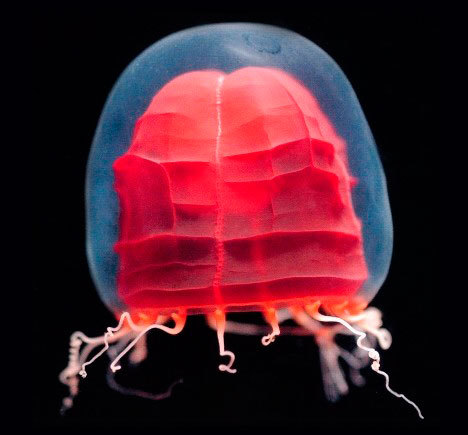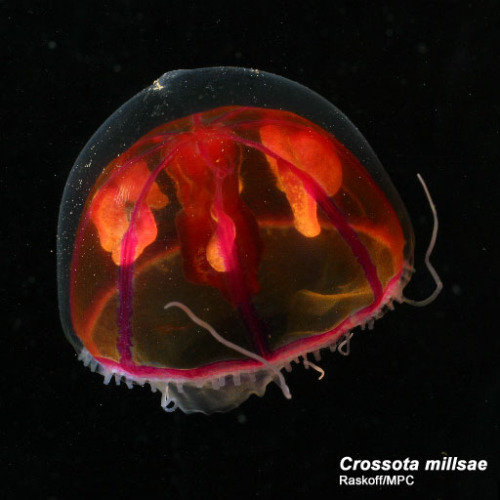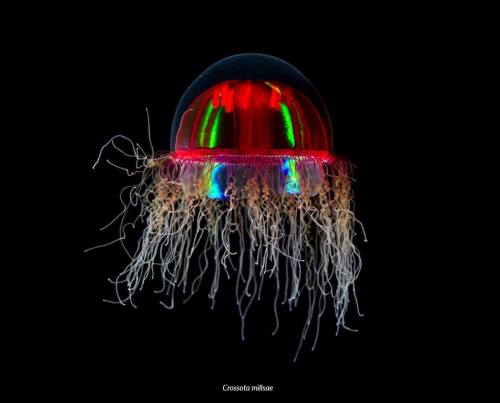Follow Your Passion: A Seamless Tumblr Journey
Cnidaria - Blog Posts


Helmet Jelly
Periphylla periphylla
The Helmet Jelly can be found at all depths of the ocean. This vibrant and strange jellyfish tends to proliferate in Norwegian fjords. They are one of the dominant predators in these isolated ecosystems.
Photos
http://www.seawater.no/fauna/cnidaria/periphylla.html
https://www.bigfishexpeditions.com/2019/01/24/norway-deepwater-shark-diving-2018/helmet-jelly/


Lav Polyp
leuckartiara octona
The Lav Polypo is a jelly that comes in a variety of colors and shapes; it dwells about 200m in the deep ocean. The red mass inside its translucent bell is the jelly’s reproductive organs. Furthermore, it uses its dull, yellow tentacles can catch unsuspecting prey.
Photo credit: https://www.pinterest.com/pin/65935582019848580/
https://www.petjellyfish.co.uk/shop/live-jellyfish/leuckartiara-octona


Mid-water Arctic Hydrozoan
Botrynema brucei
The Mid-water Arctic Hydrozoan is a mini-jelly that is transparent with hints of blue. It thrives in freezing cold temperatures and drifts aimlessly in the Artic Ocean. Moreover, it is only 3 cm in size and floats between 900m to 2,600m.
Photo credit: https://en.wikipedia.org/wiki/Botrynema_brucei
http://www.arcodiv.org/watercolumn/cnidarian/Botrynema_brucei.html


Red Paper Lantern Medusa
Pandea rubra
The Red Paper Lantern resembles a floating, Japanese paper lantern in the deep sea. It has the ability to crumple and wrinkle its bright, red bell, and it is located at depths between 550m to 1200m. It has also been nicknamed the “origami jelly.”
Photo credit: https://commons.wikimedia.org/wiki/Category:Pandea_rubra
http://www.thegorgeousdaily.com/pandea-rubra/


Psychedelic Medusa
Crossota millsae
The Psychedelic Medusa is a deep-sea hydrozoan that is abundant in the North Pacific. The mini-jelly is found at depths between 1000m to 3800m, and are often observed drifting near the ocean floor. It also has an eccentric reproduction behavior uncommon in cnidarians. The females display viviparity, and carry the babies in her bell until they are ready to hatch.
Photo credit: http://www.arcodiv.org/watercolumn/cnidarian/Crossota_millsae.html
https://twitter.com/spothvegr/status/1030177493075079169


Atolla Jelly
Atolla wyvillei
The Atolla Jelly is a fiery, red jellyfish that has an extraordinary display of bioluminescence. When the jelly is attacked, it uses bioluminescence to produce thousands of vibrant, blue flashes; the blue flashes act as an alarm, which draws in bigger predators and warns prey. The jelly can be found at depths between 600 m to 1500m, and it also has a long hypertrophied tentacle that aids in reproduction.
Photo credit: https://en.wikipedia.org/wiki/Atolla_jellyfish
https://en.wikipedia.org/wiki/Atolla_jellyfish


Giant Bell Jelly
Scrippsia pacifica
The Giant Belly Jelly has 256 tentacles attached to a gelatinous bell-shaped base. Like most cnidarians, the Giant Belly Jelly uses specialized stinging cells called nematocysts to catch its prey. When fish and other prey swim into its tentacles, the sensory projection on the cnidocyte (cell that holds the nematocysts) is activated. Then the nematocysts and barb are released, hitting the vulnerable prey and releasing a toxin into the prey’s body. The Giant Bell Jelly is found at 400 m in the ocean. It is related to the jellyfish, but it is categorized as a Hydrozoa (similar to the Portuguese- man-o-war)
https://vimeo.com/42551565
Photo Credit: https://www.pinterest.cl/pin/467107792572034837/
https://courses.lumenlearning.com/ivytech-bio1-1/chapter/phylum-cnidaria/
this isn't related to cephalopods at all, but re: bilateral symmetry, there's actually some fairly recent (like, last 15 years) evidence that cnidarians actually evolved from bilaterally symmetric ancestors! Contrary to popular belief, a lot of sea anemones and coral polyps, though externally radial, actually have a bilateral digestive system. This could be a case of convergent evolution, but what's really remarkable is that embryonically, cnidarians develop this bilateral symmetry the same way as bilaterians, *using the same regulatory genetic pathways*! The polyp body plan is considered to be the ancestral state for cnidarians, while the "simplified" swimming jellyfish body plan probably is a secondary development, as suggested by the cnidarian fossil record and evidence of loss of body patterning genes in jellyfish. Together, this suggests the really exciting hypothesis that bilateral symmetry is actually the original ancestral state for the common ancestor of cnidarians and bilaterians, and rather than bilaterians being the ones who made the innovation of bilateral symmetry from radial, cnidarians would be the group that altered their symmetry instead! Sources: 1, 2, 3
(Echinoderms like starfish also are secondarily radial; they have bilateral larvae who undergo a very weird metamorphosis into their pentaradial adult form. Search "brachiolaria", "pluteus larva", or "auricularia larva" for pics!)
It's also a common misconception that cnidarians don't have central nervous systems. They're often said to have merely diffuse "nerve nets," and they do, but they also have a condensed ring-shaped nerve that integrates signals from across the body, basically constituting a central nervous system in all respects besides not actually having a singular "brain". In particular, there's been a lot of research into the nervous systems of box jellyfish, which are probably the most specialized among cnidarians due to their unique possession of true image-forming eyes, which they use for navigating both long and short distances as well detecting prey. One study from just last year even found evidence that box jellies display associative learning! Sources: 1, 2, 3, 4
(I believe there's also been research into the learning capabilities of echinoderms but I'm not as familiar with the literature. I know starfish do actually have image-forming eyes on their arms, which at least one species uses to navigate, though they also definitely do a lot of smelling and stuff as well. Source: 1)
Imagine yourself submerged in the prehistoric ocean. There are no fish, instead the only life forms consist of feather-like sessile organisms that sit on the seabed, filtering the current. The early organisms that evolved out of this, such as Jellyfish and Starfish, had radial anatomy. Their body structure entails a central axis from which you can split everything else. These bodies are simple, not designed for active mobility, lacking a ‘forwards’ or ‘backwards’. They didn’t even have eyes, instead interacting with and responding to the world via photoreceptive cells. What emerged from this were two developments: the evolution of complex eyes and the emergence of bilateral anatomy in early vertebrates and arthropods. In contrast to radial anatomy, bilateral anatomy entails an organism that can be split down the middle with rough symmetry. This is to say that they are built for direction. A body that is built for mobility entails significantly more complex behaviour behind its operation. Behaviour, in this sense, also becomes significantly more directed. These creatures now living in the ocean or on the sea-floor now begin to directly interact with one another. The mechanisms facilitating this interaction become pretty apparent in the fossil record; eyes, claws and antennae. The evolutionary consequences of this are the emergence of a complex nervous system alongside the presence of predation and, as Godfrey-Smith puts it “[From this point on] The mind evolved in response to other minds”.
This was from a 2015 study by Fossette et al. which observed wild Rhizostoma octopus jellyfish, aka barrel or dustbin lid jellfish, and found that they actively orient themselves and swim against the current, contrary to the popular image of scyphozoan jellies as passive directionless drifters! Based on these observations, they (the scientists) ran computer simulations of virtual jellyfish moving through ocean currents demonstrating that this active swimming is probably really really important for allowing them (the jellyfish) to form and maintain large blooms while avoiding getting stranded alone or ashore

thinking about that time scientists put tracking collars on jellyfish
Invertebrates are definitely capable of learning! A lot of people who don’t know anything about bugs say they’re automata who just do everything by instinct like an if-then computer program, and they absolutely have not looked into it because there’s SO much literature on invertebrate cognition including learning. One of the neatest papers I’ve seen was about Drosophila fruit flies (there’s a ton of fruit fly literature cuz they’re a common lab animal). So when a female fruit fly is exposed to parasitoid wasps, she will start laying fewer eggs. These researchers showed that fruit flies who have been exposed to wasps can communicate the presence of a threat via wing movements to other female fruit flies, and those flies will start laying fewer eggs too even if they haven’t seen the wasps at all, an example of social learning.
But what’s more: they can communicate threats like this not just with flies of their own species, but with flies of closely related species too. If the species are too distant, they stop being able to communicate as successfully HOWEVER these authors showed that if you house a bunch of flies together in mixed-species groups, afterwards their success at communicating goes up! This suggests the existence of a fruit fly “language” which differs between species, but which they’re capable of learning other species’ languages as well! Sources: 1, 2
see also this very scientific diagram from here:

One interesting thing about those studies is that they found that if you raise a fruit fly in isolation from hatching, it won’t be able to communicate as well. This suggests that there’s a critical period of socialization which flies require to learn how to do communicate properly and without it their ability to do so is impaired. (I believe there’s other studies on how other social interactions are affected by social isolation but I haven’t read them; again there’s sooo much fly literature ^^)
Another cool one I’ve seen is on antlion larvae, who hunt by digging pits and then waiting in the middle for ants and other bugs walking by to fall in. It’s generally thought that sedentary animals have fewer cognitive capabilities than mobile ones, due to their less demanding lifestyle, however these studies (which I’ve only skimmed) have been carried out which demonstrate that they are still capable of learning. Specifically, they can be taught to anticipate and identify approaching insects based on vibrations in the sand, and will subsequently adapt their behavior to hunt more efficiently! Even animals with what seems like a simple feeding behavior are still very capable of modifying it, which makes sense evolutionarily; while obviously different animals will require different levels of intelligence, you can imagine in a lot of cases that being able to modify your behavior based on experience is distinctly advantageous. Source 1, 2
Not an arthropod, but another bug that there’s been a lot of research into is Lymnaea pond snails, which are another common model organism for studying neurology and cognition. A ton of work has been done on their capabilities for associative learning, i.e. classical conditioning (“dog learns to salivate at the ring of a bell”) and operant conditioning (“rat learns that pressing a button gives food”). It’s been found that their ability to learn is actually a lot more complicated than just those simple kinds of stimulus ↔ response. They can take stuff they’ve learned in stressful situations (simulated experimentally by exposing them to the smell of crayfish, which eat snails) and generalize it to situations beyond just the original context, which you can imagine must be pretty important for surviving in the wild. Conversely, they can also place memories in context: when taught stuff in the presence of both crayfish smell and carrot smell, subsequently they will recall what they’ve learned in response to the carrot smell alone; in other words, they’re not just learning “carrot + crayfish smell”, but “carrot smell = crayfish smell”, placing their memories in the broader context of their environment (which again, must be helpful for survival). So they can not just learn but pretty flexibly as well! Sources 1, 2, 3
This isn't a bug at all but pretty recently there was a study that found that box jellyfish are capable of associative learning. This one research lab has done a lot of work into vision in the Caribbean box jellyfish (they have eyes btw) on both a behavior and a neurological level and have found a lot of cool things, like that these box jellyfish use their vision to navigate through their habitat of mangrove forests, and that though they don't have a brain as such, they do have a central nervous system in the form of a ring nerve connecting four small clusters of neurons that process and combine input from their eyes. I can't actually read the paper (paywall :P) but last year they did an experiment where they put jellies in a tank with darkened bars on the glass to simulate mangrove roots. Normally the jellies gauge the distance to a root by how dark it appears and then swim around it when they get near; however the bars in the experiment were colored so that they looked like they were farther away than the wall actually was. At first the jellyfish kept bumping into the all, but after several rounds of trial and error they began to avoid them, indicating that they were able to learn from the experience! Jellyfish! Aaaaa nature is so cool. Source 1, 2, 3
I have a question! About bugs and arachnids and all them. Sorry to lump them all into one category, but I'd rather not make the same post multiple times.
My question is: Can they learn "tricks?"
By this I mean are they capable of learning, in general, I suppose. Like mice in a maze, magpies with a rock.
Also, what sorts of things have they learned? How do they learn (like watching others or from experience)?
I ask because it's something that really interests me. I know the ability to learn doesn't add or subtract value from a being, it's a curious thought as I know very, very little about beetles, and spiders, and bees, and so on!
Do they just know how to do things because it's all their kind have done since the beginning of them? Do they have to learn or are capable of it?
